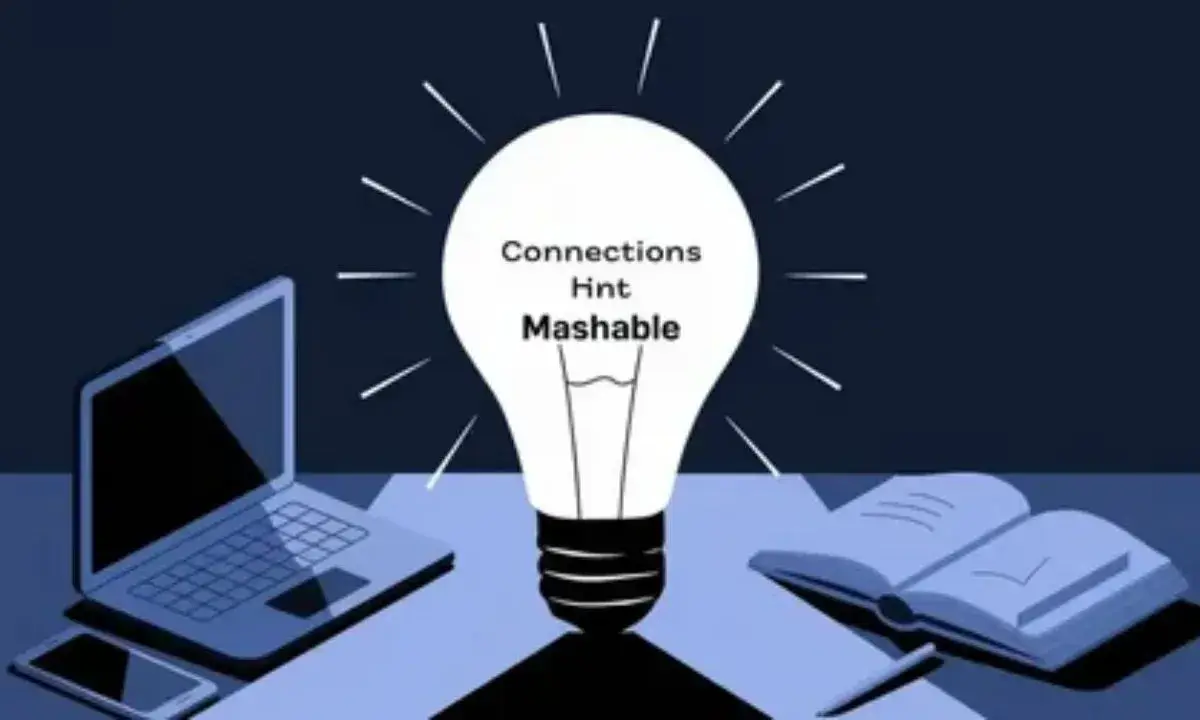If you’ve ever stared at the NYT Connections grid wondering how 16 seemingly random words connect, you’re not alone. Every day, thousands of players face the same challenge — deciphering clever word associations crafted by Wyna Liu, the puzzle’s creator. While many puzzle fans rely purely on intuition, others turn to Mashable’s NYT Connections hints, a structured system that helps players sharpen their reasoning without spoiling the fun.
This comprehensive guide dives deep into Mashable’s approach to NYT Connections hints — how they work, how to use them effectively, and how they compare to other sources. Whether you’re a casual solver or chasing a 100-day streak, this article will help you master the grid once and for all.
Introduction to NYT Connections
NYT Connections is one of The New York Times’ most popular word puzzles, joining the ranks of Wordle and the NYT Crossword. Launched in mid-2023, it challenges players to sort 16 words into four groups of four based on hidden relationships. Each puzzle follows a daily release schedule — resetting at midnight Eastern Time — and features a range of difficulty levels, from straightforward to mind-bending.
What sets Connections apart is its mix of logic, lateral thinking, and language intuition. Players need to identify subtle patterns — like movie franchises, idioms, or words with double meanings. The beauty of the puzzle lies in its simplicity of design and depth of challenge.
However, with abstract themes and misleading overlaps, players often hit roadblocks. That’s where Mashable’s NYT Connections hints come into play.
Decoding the Connections Puzzle Format
Each NYT Connections puzzle is built on a 4×4 grid containing 16 words. Your task? Identify four distinct categories linking four words each. The twist: some words seem to fit multiple groups, and not all connections are immediately clear.
Here’s the breakdown of color-coded categories:
| Color | Difficulty Level | Description |
|---|---|---|
| 🟨 Yellow | Easiest | Obvious and literal connections (e.g., “Months of the Year”) |
| 🟩 Green | Moderate | Slightly less obvious but logical (e.g., “Words Starting with ‘Micro’”) |
| 🟦 Blue | Tricky | Abstract, cultural, or thematic (e.g., “Characters Played by Tom Hanks”) |
| 🟪 Purple | Hardest | Deep associations, puns, or obscure categories (e.g., “Words That Rhyme with ‘Air’”) |
You get four mistakes per game, and once you’ve made them, the puzzle ends. Each solved set earns a color-coded highlight — rewarding both accuracy and deduction.
Mashable’s Approach to Connections Hints
Mashable, a leading digital media brand, has become the go-to hub for daily NYT Connections hints. Their editorial team provides structured, spoiler-free assistance that guides players toward the right solution without giving it away entirely.
What makes Mashable’s system stand out:
- Progressive difficulty hints — gradually revealing categories step by step.
- Human-tested clues — each hint is verified by real solvers before publication.
- Timely updates — hints go live shortly after each day’s puzzle is released.
- Community engagement — readers discuss hints, offer alternative interpretations, and correct errors collaboratively.
Their philosophy is simple: “Help players think like the puzzle maker, not just hand them the answers.”
Breaking Down Mashable’s Hint Structure
Mashable’s tiered hint system follows a consistent three-step structure:
- Category-Level Nudges – These hints give a broad theme without revealing the group.
Example: “You might wear these at the beach.”
(Category: Swimwear) - Thematic Clues – Offers contextual anchors or pop culture ties.
Example: “These names all belong to members of the same TV family.”
(Category: The Simpsons Characters) - Group Descriptor Reveal – If readers still can’t crack it, Mashable provides the direct category title.
Example: “Movies featuring Tom Cruise.”
This tiered approach caters to both casual players and experts, allowing flexible engagement. It’s one of the reasons why “Mashable NYT Connections hints today” trends daily on search platforms.
Real Examples of Mashable Hints in Action
Yellow Category Example (Easiest)
Puzzle Theme: “Things You Find in a Kitchen”
Mashable’s Hint Path:
- Hint 1: “You might reach for these when cooking.”
- Hint 2: “Essential for preparing food.”
- Reveal: “Kitchen Utensils.”
- Words: Spatula, Knife, Spoon, Whisk
Takeaway: Mashable’s easy-tier hints use straightforward contextual cues that prompt recognition instead of explanation.
Purple Category Example (Hardest)
Puzzle Theme: “Words That Sound Like Letters”
Mashable’s Hint Path:
- Hint 1: “They might make you think of the alphabet.”
- Hint 2: “Homophones of single letters.”
- Reveal: “Words That Sound Like Letters.”
- Words: Sea, Bee, Queue, Jay
Takeaway: Purple hints challenge lateral thinking and linguistic association. Mashable carefully balances between helpfulness and preserving puzzle integrity.
Difficult Mixed Case Example
Puzzle Theme: “TV Shows with Animals in the Title”
Mashable’s Hint Path:
- Hint 1: “These belong to the small screen zoo.”
- Hint 2: “Think of titles featuring furry or feathered friends.”
- Reveal: “Television Shows with Animal Names.”
- Words: BoJack, Bear, Lassie, DuckTales
Insight: Mixed-category cases highlight how themes overlap, often tricking solvers into premature groupings.
Advanced Techniques for Puzzle Solving
Mastering NYT Connections takes more than luck. It’s about recognizing patterns, semantics, and subtle cues. Here are some expert-approved strategies:
1. Use the Elimination Method
Identify one word that clearly doesn’t fit with others. Eliminating outliers helps narrow your focus to probable groupings.
2. Spot Anchor Words
Certain terms stand out as “anchors” — words that strongly define a potential theme.
Example: Paris may indicate “Capitals,” Tesla hints at “Brands,” etc.
3. Recognize Common Connection Types
- Synonyms (e.g., Large, Huge, Massive, Giant)
- Thematic (e.g., Movie Titles)
- Idiomatic (e.g., “Break,” “Ice,” “Deal,” “Heart”)
- Homophones (e.g., “See,” “Sea,” “C”)
- Category-based (e.g., “Fruits,” “Tools,” “Countries”)
4. Watch for Red Herrings
Many words fit multiple groups. Avoid jumping to conclusions until you’ve tested combinations logically.
5. Track Recurring Patterns
NYT puzzles often repeat conceptual categories every few weeks. Keeping notes can improve long-term success rates.
When and How to Use Mashable’s Hints Effectively
Using hints is about timing and discipline. Jumping too soon can spoil the fun; waiting too long can lead to frustration. Here’s a practical framework:
| Step | Action | Purpose |
|---|---|---|
| 1 | Attempt the puzzle solo | Build your reasoning first |
| 2 | Check Mashable’s first-tier hints | Get directional guidance |
| 3 | Apply your logic again | Strengthen pattern recognition |
| 4 | If stuck, read tier two hints | Clarify misdirection |
| 5 | Reveal categories only if needed | Maintain challenge integrity |
Pro Tip: Keep a personal “hint log.” Write down what you guessed before and after reading Mashable’s clues. Over time, you’ll notice improvement in pattern recognition and deductive speed.
Mashable’s Hint Community and Resources
Beyond daily hints, Mashable fosters a thriving puzzle community across multiple platforms — Reddit, Facebook, and the Mashable comment section.
Community features include:
- Reader discussions and alternate interpretations.
- Shared “aha moments” from solved puzzles.
- Direct feedback loops for improving hint clarity.
- Archive access for past puzzles by date.
Quote from a 100-day streak player:
“Mashable doesn’t just help me solve puzzles. It helps me think like the puzzle maker. That’s what makes it addictive.”
This sense of collective intelligence — where thousands collaborate over one puzzle — has made Mashable’s hint hub a cornerstone of the Connections ecosystem.
Comparative Analysis with Other Hint Sources
How does Mashable compare with other NYT Connections hint providers?
| Source | Hint Style | Spoiler Control | Community | Best For |
|---|---|---|---|---|
| Mashable | Tiered, structured, human-written | High | Strong (comments, Reddit) | Balanced, all-level players |
| Reddit r/NYTConnections | Community-driven, variable | Medium | Massive | Experienced solvers |
| Official NYT Hints | Minimal, abstract | Very High | Limited | Purists, no spoilers |
| Twitter (@ConnectionsClues) | Quick clue drops | Low | Moderate | Fast updates |
| WordPlay Daily | Analytical, technical | Medium | Active | Deep strategists |
Why Mashable Wins:
Mashable maintains editorial accuracy, timely updates, and community accessibility, giving it an edge for both new and expert players.
Tips from Connections Masters
Veteran solvers who maintain streaks of 50–100+ days share common habits. Here’s what they recommend:
- Play Daily – Regular exposure sharpens category intuition.
- Reflect on Misses – Study why a connection failed; pattern awareness is key.
- Engage Online – Discuss puzzles with communities like r/NYTConnections.
- Limit Hint Use – Treat Mashable’s hints as a study guide, not a cheat sheet.
- Track Categories – Maintain a spreadsheet of recurring themes.
Case Study:
A player nicknamed WordWhiz99 maintained a 120-day streak using a mix of Mashable hints, pattern journals, and daily Reddit reviews. Their secret?
“I use hints only when I’m genuinely stuck. It trains my brain to think thematically.”
Troubleshooting Common Connections Challenges
Even seasoned players face hurdles. Here are the most common pitfalls and how to overcome them:
| Problem | Cause | Solution |
|---|---|---|
| False Connections | Overlapping meanings | Re-evaluate context — one word may belong elsewhere |
| Ambiguous Categories | Abstract wording | Read Mashable’s tier-one hints for clarity |
| Streak Breakers | Rushing or fatigue | Slow down, take breaks between guesses |
| Conceptual Traps | Pop culture or idioms | Look for figurative meanings, not literal ones |
Remember — each failure teaches you how NYT constructs cognitive traps, enhancing your skill for future puzzles.
FAQ About Mashable’s NYT Connections Hints
| Question | Answer |
|---|---|
| Where can I find Mashable’s NYT Connections hints? | Visit Mashable’s NYT Games section and search “Connections hints.” |
| Are Mashable’s hints free? | Yes — all hints and archives are publicly available. |
| How soon after release are hints posted? | Usually within one hour after the NYT puzzle goes live. |
| Does Mashable provide past puzzle hints? | Yes, archived by date and puzzle number. |
| How are hints created? | By Mashable’s editorial team using a mix of solving, pattern mapping, and peer review. |
| Can I suggest improvements? | Absolutely — via comment sections or Mashable’s contact form. |
| Are hints ever incorrect? | Rarely. Inaccuracies are corrected quickly after community feedback. |
| How do Mashable’s hints compare to official NYT hints? | Mashable’s are progressive and reader-focused, while NYT’s are minimalist. |
Conclusion and Next Steps
Mashable’s NYT Connections hints have redefined how players engage with digital puzzles. They strike the perfect balance between assistance and autonomy, making them ideal for anyone seeking to sharpen word association and reasoning skills.
To get the most out of your daily challenge:
- Attempt first, hint later.
- Engage with the community.
- Track your patterns.
- Use Mashable’s archives to revisit older puzzles.
Every Connections puzzle is a mental workout, but with Mashable’s guidance, you’ll start to see beyond the words — into the mind of the puzzle maker

Ember Clark is an expert blogger passionate about cartoons, sharing captivating insights, trends, and stories that bring animation to life for fans worldwide.

